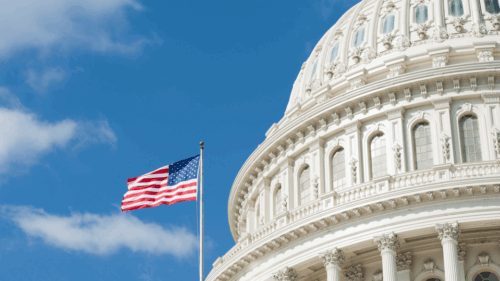On July 4, 2025, President Donald Trump signed a major tax and spending bill, commonly referred to as the “One Big Beautiful Bill Act” (OBBB Act), into law. The OBBB Act includes changes for Employee Benefits plans, including provisions that:
- Expand the availability of health savings accounts (HSAs).
- Permanently extend the telehealth exception for high deductible health plans (HDHPs).
- Increase the maximum annual limit for dependent care flexible spending accounts (FSAs).
- Allow employers to help pay employees’ student loans beyond 2025 and make cost-of-living adjustments to the tax exclusion for educational assistance programs.
- Allow employers to contribute up to $2,500 per year to a new type of tax-advantaged account for children called a “Trump Account.”
Keeping our clients informed of changes like this is a top priority for the Holmes Murphy Compliance team. We’ve made our client update available to provide additional information on the impact of the OBBB on employee benefit plans. If you have any questions or want to dive deeper into a specific area of the bill, reach out to connect with our experts.
Big Bill Benefits Changes
The legislation’s direct impact on employee benefit plans focuses on the permanent extension of telehealth relief, expanded HSA contribution eligibility, and increased annual contribution limits for DCAPs.
Permanent Extension of Safe Harbor for Absence of Deductible for Telehealth Services (Sec. 71306)
Understand:
- The telehealth exception for high deductible health plans (HDHPs) has been permanently extended and allows plans to provide or continue providing telehealth benefits before satisfying the deductible for HDHP enrollees without impacting employee HSA contributions.
- This provision is retroactive to plan years starting on January 1, 2025.
Insight:
- This is helpful for employers that implemented telehealth programs that were bundled with HDHPs and provided first dollar coverage for non-preventive health services.
- It can also be beneficial for vendors providing virtual treatments of chronic conditions.
Impact:
- Employers that do not currently provide telehealth programs that are bundled with HDHPs and provide first dollar coverage can add or alter their telehealth offering now to do so.
- Employers are not required to adopt this provision and can still require plan participants to meet the plan’s stated deductible when using telehealth services.
Treatment of Direct Primary Care Service Arrangements (Sec. 71308)
Understand:
- Individuals with direct primary care service arrangements are allowed to make HSA contributions as long as the fees for the service do not exceed $150 per month for an individual and $300 for any coverage beyond individual.
- Direct primary care fees are considered a medical care expense and can be paid for using HSA funds.
- This provision is effective as of January 1, 2026.
Insight:
- While this allows individuals to have direct primary care coverage without losing HSA contribution eligibility, it only applies to primary care services provided by a primary care practitioner. Certain services, including prescription drugs, are not allowed for a direct primary care plan to be HSA-qualified.
- The language in this section specifically calls for rulemaking for this part of the law, which will be helpful as it is unclear whether direct primary care providers cannot prescribe prescription drugs, or if they cannot dispense prescription drugs. While it is likely that it is the former, guidance would be welcome.
Impact:
- Employers should inform their team of this change ahead of open enrollment for 2026.
Enhancement of the Dependent Care Assistance Program (Sec. 70404)
Understand:
- The annual limit for DCAP contributions is increased to $7,500 for single individuals and married couples filing jointly (up from $5,000) and $3,750 for married individuals filing separately (up from $2,500).
- This provision applies to tax years starting after December 31, 2025 (i.e., the 2026 tax year).
Insight:
- Plans that have had issues passing the dependent care FSA nondiscrimination testing rules may continue having similar issues with the increased amounts.
Impact:
- Employers contemplating an increase to their DCAP limit should analyze their employee population and current DCAP utilization to determine the usefulness and feasibility of increasing the limit without running into nondiscrimination issues.
- Like the telehealth provision, employers are not required to increase their DCAP contribution limit.
More is More
Alongside the telehealth, HSA, and DCAP changes, the OBBB Act also offers additional provisions that employee benefits leaders can consider for their total benefits package.
Trump Accounts
- The OBBB Act creates “Trump Accounts,” allowing the establishment of tax-favored accounts for children under the age of 18 that include a $5,000 annual contribution limit, of which employers are allowed to make tax-free contributions up to $2,500 starting in 2026.
- Employers that contribute to these accounts must establish plan documents and will be prohibited from contributing more to highly compensated employees than to other employees.
- The Treasury Department, as a pilot program, will pay a one-time credit of $1,000 to the Trump Accounts of children who are U.S. citizens born between 2025 and 2028.
Student Loans Educational Assistance Programs
- Employers can continue offering educational assistance programs for the tax-free employer payments of student loans as the OBBB Act permanently extends this option.
Paid Family and Medical Leave Employer Credit Continuation
- The OBBB Act permanently extends the federal paid family and medical leave employer tax credit.
- It’s worth noting that it now appears that employers who provide paid leave beyond what is mandated by a state or local paid medical and family leave law can be eligible for a tax credit for the excess benefit.
Beauty for Benefits So Far
Ultimately, these changes are beneficial for plan sponsors as they will now have more options available to consider when planning for 2026. Review our OBBB update to learn more about the legislation’s effect on benefits and stay tuned for our next episode of Healthy Politics where we’ll dive into these changes. As always, we will continue to provide updates as we receive additional guidance and information.
Please note that we are still reviewing the changes to Medicaid to determine the impact that they may have on group health plans. This overview is not intended to be exhaustive nor should any discussion or opinions be construed as legal advice. Readers should contact legal counsel for legal advice.







